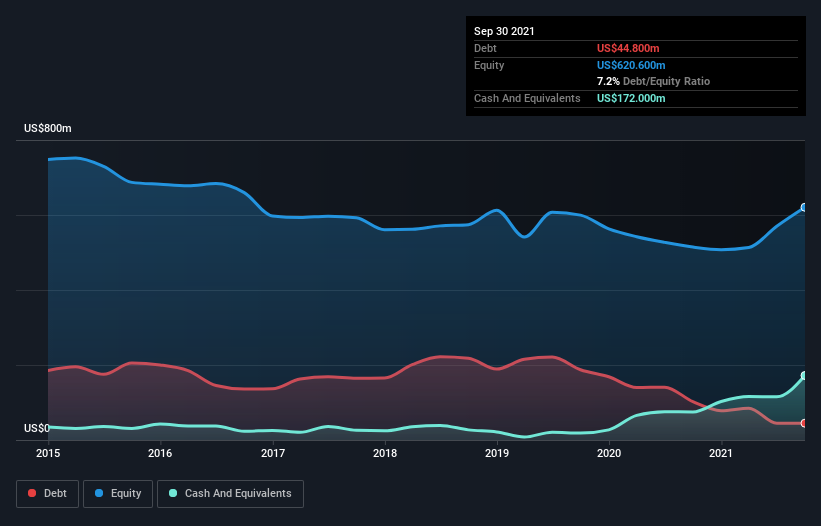
The external fund manager backed by Berkshire Hathaway's Charlie Munger, Li Lu, makes no bones about it when he says 'The biggest investment risk is not the volatility of prices, but whether you will suffer a permanent loss of capital.' So it might be obvious that you need to consider debt, when you think about how risky any given stock is, because too much debt can sink a company. Importantly, TimkenSteel Corporation (NYSE:TMST) does carry debt. But should shareholders be worried about its use of debt?
What Risk Does Debt Bring?
Generally speaking, debt only becomes a real problem when a company can't easily pay it off, either by raising capital or with its own cash flow. Ultimately, if the company can't fulfill its legal obligations to repay debt, shareholders could walk away with nothing. However, a more common (but still painful) scenario is that it has to raise new equity capital at a low price, thus permanently diluting shareholders. Of course, debt can be an important tool in businesses, particularly capital heavy businesses. The first thing to do when considering how much debt a business uses is to look at its cash and debt together.
Check out our latest analysis for TimkenSteel
What Is TimkenSteel's Net Debt?
You can click the graphic below for the historical numbers, but it shows that TimkenSteel had US$44.8m of debt in September 2021, down from US$102.2m, one year before. But on the other hand it also has US$172.0m in cash, leading to a US$127.2m net cash position.

A Look At TimkenSteel's Liabilities
Zooming in on the latest balance sheet data, we can see that TimkenSteel had liabilities of US$242.5m due within 12 months and liabilities of US$253.3m due beyond that. Offsetting these obligations, it had cash of US$172.0m as well as receivables valued at US$130.1m due within 12 months. So it has liabilities totalling US$193.7m more than its cash and near-term receivables, combined.
While this might seem like a lot, it is not so bad since TimkenSteel has a market capitalization of US$709.3m, and so it could probably strengthen its balance sheet by raising capital if it needed to. But it's clear that we should definitely closely examine whether it can manage its debt without dilution. Despite its noteworthy liabilities, TimkenSteel boasts net cash, so it's fair to say it does not have a heavy debt load!
Although TimkenSteel made a loss at the EBIT level, last year, it was also good to see that it generated US$121m in EBIT over the last twelve months. The balance sheet is clearly the area to focus on when you are analysing debt. But ultimately the future profitability of the business will decide if TimkenSteel can strengthen its balance sheet over time. So if you're focused on the future you can check out this free report showing analyst profit forecasts.
But our final consideration is also important, because a company cannot pay debt with paper profits; it needs cold hard cash. TimkenSteel may have net cash on the balance sheet, but it is still interesting to look at how well the business converts its earnings before interest and tax (EBIT) to free cash flow, because that will influence both its need for, and its capacity to manage debt. Over the last year, TimkenSteel actually produced more free cash flow than EBIT. That sort of strong cash generation warms our hearts like a puppy in a bumblebee suit.
Summing up
While TimkenSteel does have more liabilities than liquid assets, it also has net cash of US$127.2m. And it impressed us with free cash flow of US$148m, being 122% of its EBIT. So we don't think TimkenSteel's use of debt is risky. There's no doubt that we learn most about debt from the balance sheet. However, not all investment risk resides within the balance sheet - far from it. For example TimkenSteel has 2 warning signs (and 1 which makes us a bit uncomfortable) we think you should know about.
When all is said and done, sometimes its easier to focus on companies that don't even need debt. Readers can access a list of growth stocks with zero net debt 100% free, right now.
New: Manage All Your Stock Portfolios in One Place
We've created the ultimate portfolio companion for stock investors, and it's free.
• Connect an unlimited number of Portfolios and see your total in one currency
• Be alerted to new Warning Signs or Risks via email or mobile
• Track the Fair Value of your stocks
Have feedback on this article? Concerned about the content? Get in touch with us directly. Alternatively, email editorial-team (at) simplywallst.com.
This article by Simply Wall St is general in nature. We provide commentary based on historical data and analyst forecasts only using an unbiased methodology and our articles are not intended to be financial advice. It does not constitute a recommendation to buy or sell any stock, and does not take account of your objectives, or your financial situation. We aim to bring you long-term focused analysis driven by fundamental data. Note that our analysis may not factor in the latest price-sensitive company announcements or qualitative material. Simply Wall St has no position in any stocks mentioned.
About NYSE:MTUS
Metallus
Manufactures and sells alloy steel, and carbon and micro-alloy steel products in the United States and internationally.
Flawless balance sheet and fair value.
Similar Companies
Market Insights
Community Narratives



